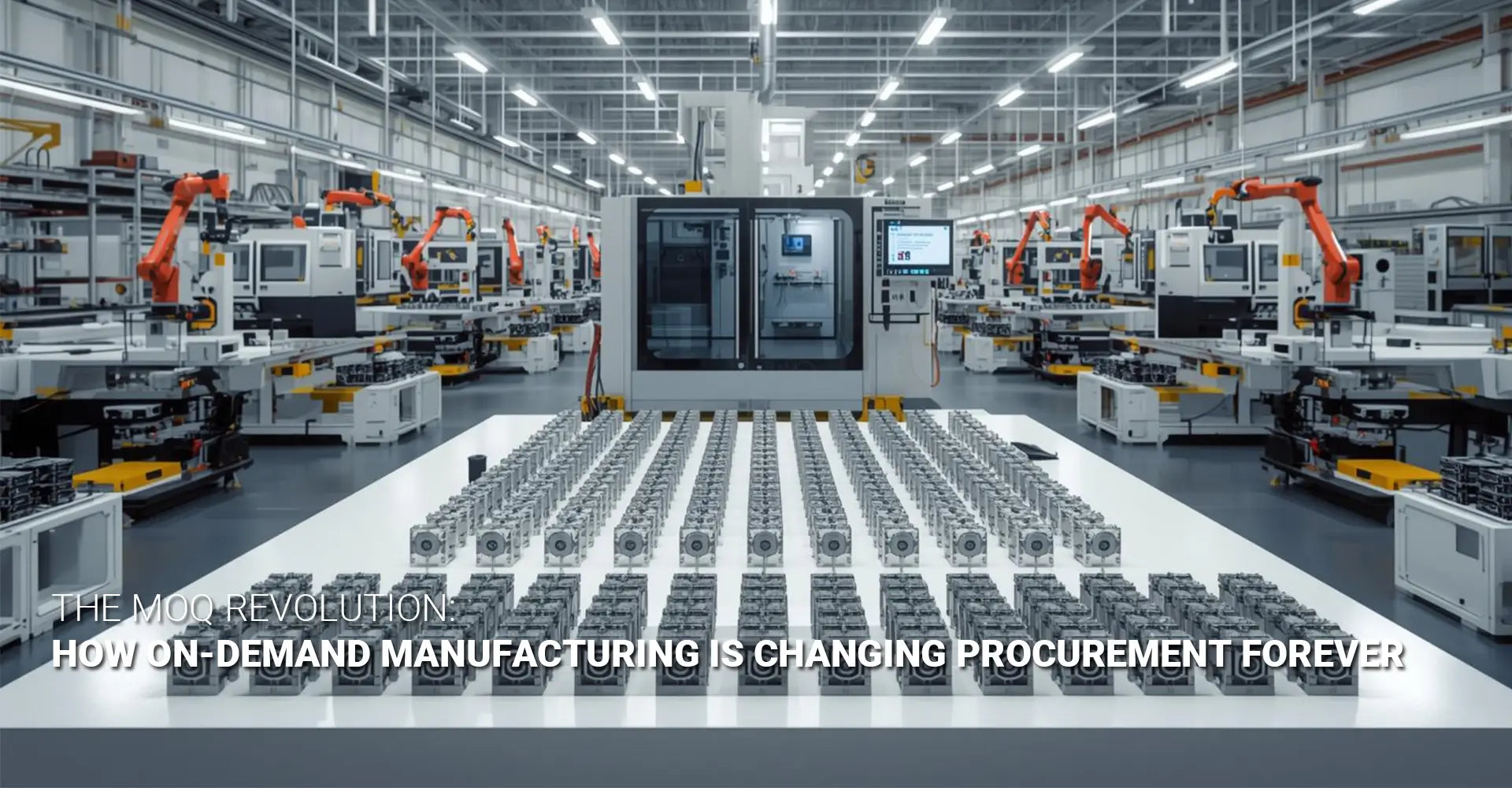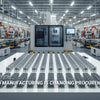Can Low-Volume Manufacturing Really Replace Traditional MOQs?

Can Low-Volume Manufacturing Really Replace Traditional MOQs?

Finding yourself stuck ordering 10,000 units when you only need 100? You're not alone. Many procurement professionals face this exact challenge every day. Traditional manufacturing has long forced businesses into uncomfortable choices: either commit to massive minimum order quantities or simply give up on their product ideas altogether.
However, something significant is happening in the manufacturing world right now. New approaches are making it possible to order exactly what you need, when you need it. This shift is changing how smart companies manage their supply chains and control costs.
Quick Answer: What You Need to Know
| Challenge | Traditional MOQ | Low-Volume Solution |
|---|---|---|
| Initial Investment | $10,000+ inventory | Order what you need |
| Lead Time | 6-12 weeks | 3-10 business days |
| Storage Costs | Ongoing warehouse fees | Minimal inventory |
| Risk Level | High obsolescence | Pay-as-you-go |
| Flexibility | Locked into quantities | Scale up or down |
The difference is striking. While traditional manufacturing locks you into large commitments, low volume on demand manufacturing lets you maintain control. You avoid tying up capital in unused inventory, reduce storage headaches, and gain the flexibility to respond quickly to market changes.
Understanding the Shift
Throughout this guide, we'll explore how reduce MOQ manufacturing is becoming not just possible, but practical for businesses of all sizes. Moreover, we'll look at real numbers, real experiences, and real strategies you can implement. Whether you're launching prototypes or managing ongoing production, this approach offers compelling advantages worth considering.
Let's dive into the hidden costs traditional manufacturing creates and why more companies are seeking alternatives.
Table of Contents
- What Are the Real Costs of Traditional High MOQs?
- How Does On-Demand Manufacturing Actually Work?
- What Do Actual Users Say About Small Batch Production?
- How Do You Calculate Your Savings with Low-Volume Manufacturing?
- Conclusion
What Are the Real Costs of Traditional High MOQs?
Traditional minimum order quantities create more problems than many businesses initially realize. On the surface, ordering 5,000 units might seem like a straightforward business decision. However, the true financial impact extends far beyond the purchase price.
The Hidden Expense Breakdown:
When you commit to high MOQs, you're actually signing up for multiple cost categories. First, there's the obvious capital investment – money that gets locked into inventory instead of flowing through your business. Additionally, warehousing expenses start accumulating immediately. Then, you face the ongoing risk of product obsolescence, especially in fast-moving industries. Finally, these large orders create significant cash flow constraints that limit your ability to invest elsewhere.
Let's break down a real example. Imagine a mid-sized electronics company ordering 5,000 custom plastic housings at $8 per unit. The immediate outlay is $40,000. Next, monthly storage costs average $500. If the product takes 18 months to sell through, that's an additional $9,000 in warehousing alone. Meanwhile, that $40,000 could have earned returns elsewhere or funded other initiatives.
Furthermore, consider the obsolescence risk. Technology changes rapidly. Customer preferences shift. Competitors introduce new features. If your product becomes outdated before you sell through inventory, those losses hit hard. Industry data suggests businesses typically write off 5-15% of inventory due to obsolescence. For our example, that could mean $2,000-$6,000 in direct losses.
The cash flow impact is perhaps most damaging. That $40,000 tied up in inventory represents opportunity cost. You can't use it to respond to new market opportunities, invest in marketing, or fund other product development. Essentially, high MOQs create a form of financial paralysis that limits business agility.
How Does On-Demand Manufacturing Actually Work?
The magic behind on-demand manufacturing benefits lies in digital transformation. Advanced technologies have fundamentally changed how manufacturers can economically handle smaller orders. Instead of requiring extensive manual setup for each job, digital systems streamline the entire process from quote to delivery.
The Process Simplified:
The journey begins when you upload your digital design file. Immediately, automated systems analyze your specifications and generate accurate quotes within minutes or hours, not days. Once you approve, production scheduling happens automatically, fitting your order into the most efficient manufacturing slot. Then, small batch production proceeds using digitally-controlled equipment that requires minimal setup time. Throughout manufacturing, automated quality checks ensure consistency. Finally, parts ship directly to you without sitting in warehouses.

This approach works because digital manufacturing eliminates traditional bottlenecks. Conventional manufacturing required extensive manual setup – tooling changes, machine adjustments, and quality calibration. Each setup cost money and time, making small orders economically unfeasible. However, CNC machining services now use computer-controlled precision that adapts quickly between different jobs.
The economics are straightforward. When setup costs drop dramatically through automation, the break-even point for profitability shifts downward. Manufacturers can now profit on orders of 50 or 100 units instead of requiring thousands. Digital quoting systems reduce administrative overhead. Automated scheduling maximizes equipment utilization. Quality control sensors replace manual inspection for many processes.
For businesses, this means unprecedented flexibility. Need 75 custom parts low volume for a market test? No problem. Want to bridge the gap from prototype to production with a 200-unit pilot run? Easily done. The technology enables manufacturers to say "yes" where they previously had to decline.
What Do Actual Users Say About Small Batch Production?
Real-world experiences tell the most convincing story. Across manufacturing forums, industry groups, and business communities, similar themes emerge consistently. Companies that have embraced minimum order quantity reduction strategies report transformative results.
Common Success Patterns:
Startup founders frequently share how low-volume manufacturing saved their businesses. Without needing $50,000 for initial inventory, they could validate product-market fit with modest investments. Next, maintenance teams at industrial machinery companies describe dramatically reduced spare parts inventories. Instead of stocking dozens of each component "just in case," they order replacements as needed. Additionally, product developers praise the ability to test multiple variations without massive commitments. Finally, niche manufacturers serving specialized markets report finding sustainable business models that wouldn't work with traditional MOQs.

One particularly insightful discussion thread highlighted a mid-sized company's experience. They had been ordering 2,000 units quarterly from an overseas supplier. Shipping took six weeks. Warehousing costs ran $800 monthly. Obsolescence losses averaged 8% annually. After switching to domestic on-demand production, they order 300 units monthly. Lead times dropped to one week. Storage costs fell to $150 monthly. Obsolescence essentially disappeared because inventory turns over rapidly.
The electronics manufacturing sector shows particularly strong adoption. Product lifecycles are short, specifications change frequently, and holding excess inventory is risky. Companies report that on-demand approaches let them respond to engineering changes without scrapping thousands of obsolete parts.
Interestingly, users also discuss quality improvements. With smaller batches, manufacturers can maintain tighter process control. Problems get identified and corrected quickly rather than affecting thousands of units. Several forum participants noted that their defect rates actually decreased when switching to lower-volume suppliers who could focus more carefully on each order.
The lesson is clear: this isn't just theoretical. Real businesses across diverse industries are successfully implementing these strategies and achieving measurable improvements in cost, flexibility, and responsiveness.
How Do You Calculate Your Savings with Low-Volume Manufacturing?
Numbers don't lie, and the financial case for on-demand approaches often proves more compelling than businesses initially expect. However, you need to look beyond simple per-unit pricing. The total cost of ownership tells the real story.
The True Cost Formula:
Traditional manufacturing requires calculating multiple factors. Start with the unit price multiplied by the MOQ. Then add monthly storage costs multiplied by how long inventory will sit. Include carrying costs – the opportunity cost of capital tied up in inventory, typically calculated at your company's cost of capital. Finally, factor in obsolescence risk, usually 5-15% annually depending on your industry. This gives you the traditional total cost.
For on-demand manufacturing, the calculation is simpler. Take the unit price (which may be higher per piece) and multiply by your actual need. Add minimal storage costs since inventory turns quickly. That's essentially your total cost. The difference between these approaches, plus improved cash flow benefits, represents your net savings.
Let's work through a concrete example using CNC metals and plastics components. Suppose you need approximately 1,200 units annually of a custom bracket.
Traditional Approach:
- MOQ: 2,000 units at $12 each = $24,000
- Storage: $400/month × 10 months (time to use 2,000 units) = $4,000
- Carrying cost: $24,000 × 8% annual rate × 0.83 years = $1,600
- Obsolescence risk: $24,000 × 7% = $1,680
- Total: $31,280 for 2,000 units = $15.64 per unit used
On-Demand Approach:
- Order 100 units monthly at $15 each = $18,000 annually for 1,200 units
- Storage: $100/month × 12 months = $1,200
- Carrying cost: Minimal (inventory turns monthly)
- Obsolescence risk: Essentially zero
- Total: $19,200 for 1,200 units = $16.00 per unit
Wait – the per-unit cost looks higher, right? Look closer. You're spending $19,200 total versus $31,280, saving $12,080. Plus, you have $24,000 less capital tied up at any given time. That capital can work elsewhere in your business.
The break-even calculation depends on your specific situation. Generally, if you're ordering more than twice your actual annual need, or if storage costs exceed 15% of product value annually, on-demand approaches will save money. The savings grow larger when you factor in reduced obsolescence risk and improved cash flow.
Furthermore, consider the strategic value. With on-demand manufacturing, you can respond quickly to design improvements, customer feedback, or market changes. Traditional MOQs lock you into specifications that might become outdated before inventory depletes. This flexibility has real economic value, even if it's harder to quantify precisely.
Conclusion
The manufacturing landscape is changing, and businesses that recognize this shift gain significant advantages. Traditional minimum order quantities made sense in an analog world where setup costs dominated economics. Today, digital technologies have rewritten those rules entirely.
Low-volume, on-demand manufacturing isn't just a convenience – it's a strategic procurement decision with measurable bottom-line impact. You reduce capital requirements, minimize storage headaches, eliminate obsolescence risk, and gain the flexibility to respond quickly to changing market conditions. These benefits compound over time, creating stronger, more agile businesses.
The numbers support this shift. Real users report positive experiences across diverse industries. The cost calculations often favor on-demand approaches, especially when you account for total ownership costs rather than just per-unit pricing.
Perhaps most importantly, this approach removes barriers that previously stopped good ideas from becoming real products. Entrepreneurs can test concepts without massive upfront investments. Established companies can experiment with new variations without risking huge commitments. Maintenance teams can stock smarter, not bigger.
The question isn't whether low-volume manufacturing can replace traditional MOQs. For many applications, it already has. The real question is whether your business is taking advantage of these capabilities yet. The sooner you explore these options, the sooner you'll start capturing the benefits.
[External Links Recommendation]
[low volume on demand manufacturing][^1]
[reduce MOQ manufacturing][^2]
[on-demand manufacturing benefits][^4]
[prototype to production][^5]
---
[^1]: Understanding low volume on demand manufacturing can help businesses optimize production and reduce costs.
[^2]: Exploring ways to reduce MOQ can significantly enhance flexibility and efficiency in production processes.
[^3]: Exploring this link will provide insights into how small batch production can enhance flexibility and reduce waste.
[^4]: Exploring this resource will provide insights into how on-demand manufacturing can enhance efficiency and reduce costs.
[^5]: Understanding this process is crucial for businesses looking to streamline their product development and launch.





